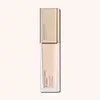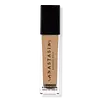What's inside
What's inside
 Key Ingredients
Key Ingredients

 Benefits
Benefits

 Concerns
Concerns

 Ingredients Side-by-side
Ingredients Side-by-side

Water
Skin ConditioningCyclopentasiloxane
EmollientPhenyl Trimethicone
Skin ConditioningC12-15 Alkyl Benzoate
AntimicrobialButylene Glycol
HumectantTalc
AbrasiveCetyl PEG/PPG-10/1 Dimethicone
EmulsifyingPolyglyceryl-4 Isostearate
EmulsifyingSodium Chloride
MaskingVinyl Dimethicone/Methicone Silsesquioxane Crosspolymer
Phenoxyethanol
PreservativePolymethylsilsesquioxane
Dimethicone/Vinyl Dimethicone Crosspolymer
Skin ConditioningDisteardimonium Hectorite
StabilisingSodium Dehydroacetate
PreservativeAlumina
AbrasiveHydrogen Dimethicone
Xanthan Gum
EmulsifyingAluminum Hydroxide
EmollientSodium Gluconate
Skin ConditioningEthylhexylglycerin
Skin ConditioningHelianthus Annuus Seed Oil
EmollientTocopherol
AntioxidantBeta-Sitosterol
Emulsion StabilisingSqualene
EmollientCI 77891
Cosmetic ColorantCI 77492
Cosmetic ColorantCI 77499
Cosmetic ColorantCI 77491
Cosmetic ColorantWater, Cyclopentasiloxane, Phenyl Trimethicone, C12-15 Alkyl Benzoate, Butylene Glycol, Talc, Cetyl PEG/PPG-10/1 Dimethicone, Polyglyceryl-4 Isostearate, Sodium Chloride, Vinyl Dimethicone/Methicone Silsesquioxane Crosspolymer, Phenoxyethanol, Polymethylsilsesquioxane, Dimethicone/Vinyl Dimethicone Crosspolymer, Disteardimonium Hectorite, Sodium Dehydroacetate, Alumina, Hydrogen Dimethicone, Xanthan Gum, Aluminum Hydroxide, Sodium Gluconate, Ethylhexylglycerin, Helianthus Annuus Seed Oil, Tocopherol, Beta-Sitosterol, Squalene, CI 77891, CI 77492, CI 77499, CI 77491
Water
Skin ConditioningCyclopentasiloxane
EmollientIsododecane
EmollientCaprylyl Methicone
Skin ConditioningC12-15 Alkyl Benzoate
AntimicrobialEthylhexyl Palmitate
EmollientPolyglyceryl-4 Isostearate
EmulsifyingHexyl Laurate
EmollientCetyl PEG/PPG-10/1 Dimethicone
EmulsifyingGlycerin
HumectantTrimethylsiloxysilicate
EmollientButylene Glycol
HumectantVinyl Dimethicone/Methicone Silsesquioxane Crosspolymer
Sodium Chloride
MaskingLaminaria Ochroleuca Extract
Skin ConditioningAlanine
MaskingArginine
MaskingGlycine
BufferingIsoleucine
Skin ConditioningHistidine
HumectantPhenylalanine
MaskingProline
Skin ConditioningThreonine
Serine
MaskingAspartic Acid
MaskingValine
MaskingSodium PCA
HumectantPanthenol
Skin ConditioningTocopheryl Acetate
AntioxidantAllantoin
Skin ConditioningSodium Lactate
BufferingPCA
HumectantEthylhexylglycerin
Skin ConditioningCaprylic/Capric Triglyceride
MaskingSimethicone
EmollientTetrasodium EDTA
Triethoxycaprylylsilane
Zinc Stearate
Cosmetic ColorantLauryl PEG-9 Polydimethylsiloxyethyl Dimethicone
Skin ConditioningStearalkonium Hectorite
Gel FormingPropylene Carbonate
SolventPhenoxyethanol
PreservativeChromium Oxide Greens
CI 77007
Cosmetic ColorantIron Oxides
CI 77891
Cosmetic ColorantWater, Cyclopentasiloxane, Isododecane, Caprylyl Methicone, C12-15 Alkyl Benzoate, Ethylhexyl Palmitate, Polyglyceryl-4 Isostearate, Hexyl Laurate, Cetyl PEG/PPG-10/1 Dimethicone, Glycerin, Trimethylsiloxysilicate, Butylene Glycol, Vinyl Dimethicone/Methicone Silsesquioxane Crosspolymer, Sodium Chloride, Laminaria Ochroleuca Extract, Alanine, Arginine, Glycine, Isoleucine, Histidine, Phenylalanine, Proline, Threonine, Serine, Aspartic Acid, Valine, Sodium PCA, Panthenol, Tocopheryl Acetate, Allantoin, Sodium Lactate, PCA, Ethylhexylglycerin, Caprylic/Capric Triglyceride, Simethicone, Tetrasodium EDTA, Triethoxycaprylylsilane, Zinc Stearate, Lauryl PEG-9 Polydimethylsiloxyethyl Dimethicone, Stearalkonium Hectorite, Propylene Carbonate, Phenoxyethanol, Chromium Oxide Greens, CI 77007, Iron Oxides, CI 77891
 Reviews
Reviews

Ingredients Explained
These ingredients are found in both products.
Ingredients higher up in an ingredient list are typically present in a larger amount.
Butylene Glycol (or BG) is used within cosmetic products for a few different reasons:
Overall, Butylene Glycol is a safe and well-rounded ingredient that works well with other ingredients.
Though this ingredient works well with most skin types, some people with sensitive skin may experience a reaction such as allergic rashes, closed comedones, or itchiness.
Learn more about Butylene GlycolC12-15 Alkyl Benzoate is made up of Benzoic Acid and long chain alcohols. It has a low molecular weight.
C12-15 Alkyl Benzoate is an emollient and texture enhancer. Due to its solubility, it is often used in sunscreens to help evenly distribute active ingredients.
As an emollient, C12-15 Alkyl Benzoate helps soften and hydrate your skin. Emollients create a film on your skin that traps moisture within.
This ingredient has been reported to cause eye irritation.
Learn more about C12-15 Alkyl BenzoateThis ingredient is a high molecular weight silicone. It has emulsifying and skin conditioning properties.
Ci 77891 is a white pigment from Titanium dioxide. It is naturally found in minerals such as rutile and ilmenite.
It's main function is to add a white color to cosmetics. It can also be mixed with other colors to create different shades.
Ci 77891 is commonly found in sunscreens due to its ability to block UV rays.
Learn more about CI 77891Cyclopentasiloxane, or D5, is a silicone used to improve texture of products and trap moisture.
D5 is considered lightweight and volatile. Volatile means it evaporates quickly after application. Once evaporated, D5 leaves a thin barrier that helps keep skin hydrated.
It is also an emollient. Emollients help soften the skin and prevent water loss. Silicones create a silky texture in products. D5 helps other ingredients become more spreadable.
Studies show D5 is safe to use in skincare products. We recommend speaking with a skincare professional if you have concerns.
Learn more about CyclopentasiloxaneEthylhexylglycerin (we can't pronounce this either) is commonly used as a preservative and skin softener. It is derived from glyceryl.
You might see Ethylhexylglycerin often paired with other preservatives such as phenoxyethanol. Ethylhexylglycerin has been found to increase the effectiveness of these other preservatives.
Phenoxyethanol is a preservative that has germicide, antimicrobial, and aromatic properties. Studies show that phenoxyethanol can prevent microbial growth. By itself, it has a scent that is similar to that of a rose.
It's often used in formulations along with Caprylyl Glycol to preserve the shelf life of products.
This ingredient is an emulsifer and stabilizer. It comes from isostearic acid and polyglycerin.
As an emulsifier, it helps blend oil and water to improve texture, spreadbility, and application.
Due to it being derived from isostearic acid, this ingredient may not be fungal acne safe.
Learn more about Polyglyceryl-4 IsostearateChances are, you eat sodium chloride every day. Sodium Chloride is also known as table salt.
This ingredient has many purposes in skincare: thickener, emulsifier, and exfoliator.
You'll most likely find this ingredient in cleansers where it is used to create a gel-like texture. As an emulsifier, it also prevents ingredients from separating.
There is much debate on whether this ingredient is comedogenic. The short answer - comedogenic ratings don't tell the whole story. Learn more about comegodenic ratings here.
The concensus about this ingredient causing acne seems to be divided. Research is needed to understand if this ingredient does cause acne.
Scrubs may use salt as the primary exfoliating ingredient.
Learn more about Sodium ChlorideThis ingredient is used in makeup and skincare to thicken formulas, reduce shine, and give skin a silky-smooth feel.
It’s a white silicone powder that sits in fine lines and pores to blur their appearance though its effectiveness depends on the particle size.
You'll typically find this ingredient in amounts between 0.1-20%.
Learn more about Vinyl Dimethicone/Methicone Silsesquioxane CrosspolymerWater. It's the most common cosmetic ingredient of all. You'll usually see it at the top of ingredient lists, meaning that it makes up the largest part of the product.
So why is it so popular? Water most often acts as a solvent - this means that it helps dissolve other ingredients into the formulation.
You'll also recognize water as that liquid we all need to stay alive. If you see this, drink a glass of water. Stay hydrated!
Learn more about Water